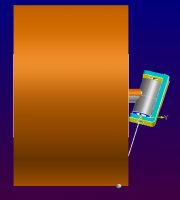12jr champ
Member
I was trying to fix a push from the center off on asphalt.
Increasing negative camber raises the RF tire, how does that not affect cross?
More contact patch less RF camber increases turning force and has more effect on exit.My question is.. what has more effect? Camber thrust increasing the tires turning force when camber is raised, Or more contact patch on the racing surface increasing the tires turning force when the camber is lowered? And does one have more effect in one part of the corner than the other?
If you were to do it with a RF camber change only you would decrease RF neg camber.I was trying to fix a push from the center off on asphalt.
1° camber, with a 6 1/2 inch spindle arm, raises the end of the arm .122 inches. Is that not significant?we only deal with 1 degree range of adjustment al not 4 or 5
I feel this also allows you to turn under someone off the corner. Do you give up a little roll speed yes but when my driver can cut through traffic and not have the kart getting crossed up it seems to work for us.More contact patch less RF camber increases turning force and has more effect on exit.
I'm not assuming anything. It is as I stated. I have the CAD/CAM drawings to prove it.You're assuming that the right-front corner has positive scrub radius Al. It may have very little or none, in which case a camber change has no effect on cross.
PM
Perpendicular to the ground at the center of the tire contact patch, (where it really matters), with near zero scub radius, how much does the chassis raise, or lower?1° camber, with a 6 1/2 inch spindle arm, raises the end of the arm .122 inches. Is that not significant?
Thanks!! So to continue, where do you feel like camber thrust comes into play?More contact patch less RF camber increases turning force and has more effect on exit.
Lol I don’t even know what camber thrust is? Please explainThanks!! So to continue, where do you feel like camber thrust comes into play?
I would't worry about it, I like to keep things simple, I've never seen anywhere to fix a handling issue say adjust camber thrust, to me it's just a term smart guy's that race on paper talk about.Thanks!! So to continue, where do you feel like camber thrust comes into play?
That's what you're calling our discussions now, "bickering"!! That has, in my mind, a very negative connotation!!Perpendicular to the ground at the center of the tire contact patch, (where it really matters), with near zero scub radius, how much does the chassis raise, or lower?
We've been over this several times. May need to find something else to bicker about.
It’s basically where when you lean a tire (camber) it produces a force in the direction it’s leaning.Lol I don’t even know what camber thrust is? Please explain

Regardless of how you read the definition, there are 2 things that are undeniable.Speaking of scrub radius, if my understanding of Wikipedia's description is correct, because of the relatively huge amounts of caster we use on karts, our tires do not pivot around that point on the ground that Wikipedia describes. Am I not seeing this clearly?
That point that Wikipedia describes as a tire rotation relationship is in front of the tire with only 12° caster, as in the picture. Wikipedia's illustration is with no caster.
View attachment 11326
At track camber changes vary slightly, say going from 2.75 degrees to 2.5, or vice versa, most times just a turn of a flat or two. If you are making a 1 degree change in camber, you were never close to proper camber to begin with.1° camber, with a 6 1/2 inch spindle arm, raises the end of the arm .122 inches. Is that not significant?
